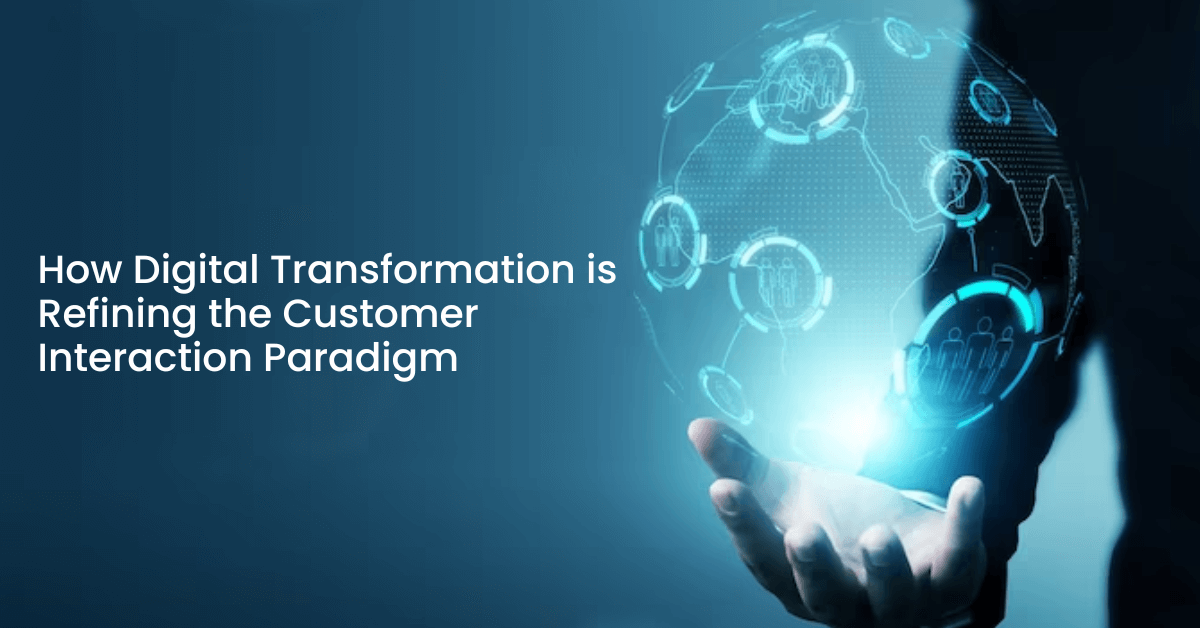How Digital Transformation is Refining the Customer Interaction Paradigm

Implementing a ‘Digital-First’ Strategy in Customer Experience
The adoption of a ‘Digital-First’ approach in enhancing customer experience involves leveraging advanced technologies like machine learning, automation, blockchain, and the Internet of Things (IoT). These technologies facilitate a more precise and timely response to customer needs. The integration of such tools has improved the digital transformation customer experience, giving rise to a new profile of the modern consumer who is more informed, connected, and tech-savvy. Let’s understand why is digital customer experience important for businesses in an aggressively competitive market today.
Defining the ‘Digital-First Customer Experience’
The concept of a ‘digital-first customer experience’ encapsulates the evolving necessity for businesses to adopt a mindset that prioritizes digital innovation in enhancing consumer engagement. This strategy aligns consumer expectations with the rapidly evolving digital environment, empowering businesses to develop and offer innovative products and services. It represents a paradigm shift where digital channels and interactions become the primary focus and driving force in designing customer experiences.
But as a digital-first business, how to improve digital customer experience?
The answer is rooted in current digital trends that narrow the gap between businesses and their users. By tapping into these trends, companies can not only meet but exceed digital transformation customer experience, offering more personalized, efficient, and engaging experiences. This digital alignment not only caters to the immediate needs of consumers but also anticipates future demands, thereby fostering a more proactive and dynamic approach to customer engagement.

Understanding The Impact Of Digital Transformation On Customer Experience
Over the years, customer preferences have evolved towards establishing enduring relationships with brands as opposed to engaging in isolated transactions. Customers who feel a sense of personalization and emotional connection with a business exhibit a threefold increase in their lifetime commitment value and are more inclined to advocate for the brand’s products or services.
To cater to these evolving digital transformation customer experience needs, enterprises are increasingly adopting digital transformation strategies characterized by instantaneous service delivery, the provision of seamless omnichannel experiences, and round-the-clock online accessibility. These strategic shifts are enabling businesses to foster closer connections with their customer base.
Outlined below are several prevailing digital trends that explain the impact of digital transformation on customer experience.
1. Personalizing the Digital Transformation Customer Experience with Recognition, Recommendations, and Recall
Recent research indicates that over 75% of consumers show a greater affinity for digital customer services that incorporate personalization strategies. These strategies include:
Individual Recognition – Customers are more inclined to engage with online platforms when they are addressed by their names, fostering a sense of familiarity and importance.
Relevant Recommendations – The provision of tailored product or content recommendations based on previous purchases or user preferences significantly influences customers’ spending behavior in the digital sphere.
Remembered Preferences – When a company demonstrates an understanding of a customer’s purchase history, it not only encourages repeat business but also reinforces a sense of loyalty.
A prime example of this technology and customer experience is observed in Netflix, an online streaming application renowned for its commitment to personalizing the digital customer experience and optimizing the overall digital transformation customer journey.
2. Creating a Unified Customer Journey Across Multiple Channels
The proliferation of technological touchpoints has afforded customers multiple channels for interaction. However, these customers often desire a seamless and consistent digital transformation customer journey across these channels, rather than perceiving each interaction as a distinct experience. Establishing a seamless multi-channel ecosystem yields several benefits, including:
Consistent Customer Experience – A unified, seamless multi-channel approach results in a uniform digital transformation customer experience, contributing to enhanced satisfaction and long-term loyalty, as highlighted by McKinsey.
Cost-Efficient Issue Resolution – A positive multi-channel experience correlates with customer satisfaction, ultimately reducing the volume of inquiries directed towards customer care channels. This reduction translates to lower operational costs for issue resolution.
Companies are strategically dismantling business silos, harnessing the full potential of customer data, and continuously refining their processes to deliver relevant and consistent experiences to customers, regardless of the channel or device they choose for engagement.
3. Harnessing the Power of Automation
Recent surveys reveal that a remarkable 84% of consumers prefer interactions with computer automated systems. These systems offer several advantages, including round-the-clock availability, reduced bias, and rapid response times, thereby elevating the overall digital customer experience. If your business has yet to embrace automation as an integral component of its digital transformation customer experience, it is advisable to initiate this transformation promptly.
Key advantages of integrating automation in your business include:
Time Efficiency: Automated responses ensure swift engagement and service delivery, eliminating the need for customers to wait for human assistance. In today’s digital landscape, where immediate responses are the norm, automation caters to customers’ expectations for rapid service, regardless of the time or date.
Bias Mitigation: Automation mitigates the risk of perceived rudeness or bias often associated with human advisors. Automated communication remains consistently polite and impartial, promoting positive customer interactions.
Enhanced Team Efficiency: For a comprehensive digital customer experience transformation, it is imperative to automate basic processes such as follow-up emails and ticket prioritization. This not only boosts team efficiency but also contributes to a more efficient and effective customer service operation.
4. Enhancing User Experience through Effective App Onboarding
Customers have high expectations when it comes to navigating through applications, and any hurdles encountered may deter them from further app usage or recommendations. Consequently, when developing apps to facilitate enterprise digital experience transformation, diligent attention is given to the concept of app onboarding. App onboarding represents a systematic process designed to facilitate user comprehension of the application and its functionalities.
This process often incorporates on-screen guidance, complemented by the presence of an interactive virtual assistant that offers step-by-step demonstrations. Such enhancements significantly contribute to an enriched digital transformation customer experience. The advantages of prioritizing enhancements in digital transformation customer experience are multifaceted:
Customer-Centricity: An app with robust onboarding practices signifies a customer-centric approach, where the application is geared towards providing tangible value to users, simplifying their lives in the digital landscape.
Usability and Satisfaction: The ease of use of an application directly correlates with an exceptional customer experience. A satisfied customer not only becomes a brand ambassador but also serves as a potent marketing agent.
Credibility Establishment: A well-structured onboarding process fosters credibility with customers, establishing trust and reliability in the application.
5. Real-Time Customer Updates
Maintaining a strong for digital transformation customer experience entails keeping customers informed and engaged throughout their interaction with the product or service. The practice of keeping customers updated involves the orchestration of automated processes and real-time tracking mechanisms.
For instance, consider Amazon’s digital platform, which excels in providing timely updates to customers. The application ensures that customers receive real-time notifications regarding order reviews, payment completions, estimated delivery times, and more.
6. Humanizing Digital Interactions
In an era dominated by digital interfaces, maintaining a human touch is essential for fostering long-term relationships and genuine connections with customers. Strategies to humanize digital experiences include:
- Narrating Brand Stories: Utilize multimedia formats like videos or blogs to convey the brand’s history, mission, values, and vision.
- Leveraging AI for Feedback: Implement AI-driven tools to gather and act upon customer feedback, enhancing digital engagement and continuous improvement of the application.
- Personalized Content Delivery: Tailor content to individual customer needs, thereby elevating the overall user experience.
- Investing in Customer Experience Technologies: Focus on technologies that provide insights into customer behaviors and preferences.
These approaches underscore the importance of integrating digital technologies like AI, chatbots, big data analytics, cloud computing, machine learning, and VR to maintain a human-centric approach in digital transformations.
Strategic Benefits of Integrating Digital Transformation In Customer Service
Digital transformation in customer service serves as a catalyst for businesses focused on continuous innovation and enhancement. To fully reap its benefits and effectively address the challenges of today’s digital economy, businesses must equip themselves with robust digital transformation strategies. The implementation of the customer experience digital transformation strategies yields substantial benefits, including:
- Digitalization of Operations: Converting traditional business processes to digital frameworks, enhancing efficiency and operational agility.
- Expansive Customer Analytics: Garnering extensive insights into customer preferences and behaviors through advanced data analysis, enabling more targeted business strategies.
- Creation of Digital Services: Establishing innovative digital offerings, thereby expanding the business’s service capabilities and competitive edge in the market.
- Resource Management Optimization: Employing digital tools for streamlined management of resources, leading to improved allocation and utilization.
- Customer Experience Enhancement: Leveraging digital platforms to provide personalized and efficient customer interactions, significantly improving the overall customer journey.
- Fostering a Digital-First Culture: Cultivating an organizational culture that embraces digital innovation, encouraging continuous learning and digital fluency among employees.
- Global Market Access: Utilizing digital platforms to extend business reach into international markets, capitalizing on the global connectivity afforded by digital channels.
- Cost Reduction: Achieving operational cost savings through process automation and the minimization of labor-intensive activities.
- Elevating Employee Engagement: Enhancing workplace culture and employee satisfaction through digital collaboration tools and modern workplace practices.
The Roadmap to Successful Business Digitalization
Digital transformation, often misconstrued as merely an increase in digital technology utilization, fundamentally represents a shift in business operations and mindset. It demands a new approach to working and strategic thinking. To effectively enhance digital transformation and customer experience, consider the following elements:
1. Seamless Multi-Channel Integration
Users expect a consistent experience across all digital channels. Integrating these channels to work in unison not only simplifies the user journey but also significantly improves overall customer satisfaction.
2. Enhanced Personalization through CRM Software
Utilizing Customer Relationship Management (CRM) software enables businesses to analyze consumer purchase histories and behaviors. This analysis aids in delivering tailored experiences to consumers, aligning with their expectations for personalization.
3. Leveraging Cloud Computing
Adopting cloud technology offers agility and flexibility, essential for promptly addressing customer needs. This environment supports rapid, dynamic business operations, allowing for cost-effective and low-risk experimentation with new projects. For example, integrating Software as a Service (SaaS) applications like Salesforce consolidates customer, prospect, and lead data onto a single platform. Moreover, cloud solutions provide automated updates on new features, keeping customers informed and engaged.
4. Inclusive Employee Engagement
A key barrier to successful digital transformation is employee resistance. Gartner reports highlight that collaborative and goal-oriented work cultures can accelerate the pace of digital transformation. Ensuring that all team members are engaged and understand the transformation objectives is crucial for a successful transition.
In essence, digital transformation is not just about adopting new technologies but about revolutionizing business practices, strategies, and culture to meet evolving customer needs and market dynamics.

OneClick’s Transformation Solutions for Businesses
For businesses aiming to expand, adapt, and outperform competitors, adopting digital transformation is essential. This process is intrinsically linked with enhancing digital transformation customer experience, a critical aspect in today’s market where customer expectations are exceedingly high. Successfully meeting these expectations is fundamental to not just thrive but also to sustain business viability.
OneClick specializes in aiding businesses through this digital evolution. We offer comprehensive digital transformation services, including:
Digitalization Consulting
Providing expert guidance to transition your business operations and services into the digital realm effectively. This involves strategizing on integrating digital technologies into various aspects of your business to optimize processes, increase efficiency, and improve service delivery.
Digital Customer Experience Strategies
Developing tailored strategies to elevate the digital transformation customer experience for your buinsess. This encompasses the implementation of the latest customer experience technologies and innovative methods to engage customers, thereby encouraging increased utilization of your digital platforms.
The key to effective digital transformation customer experience lies in continuously exploring and integrating new customer experience technologies, alongside inventing creative approaches to keep customers actively engaged and invested in your digital offerings. OneClick supports businesses in not just adopting digital transformation practices but excelling at them, ensuring they remain competitive and successful in a rapidly evolving business arena.





